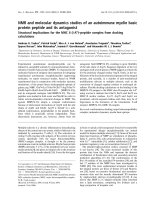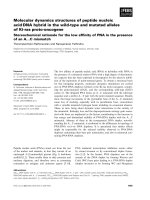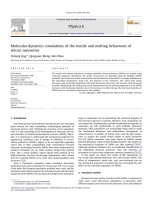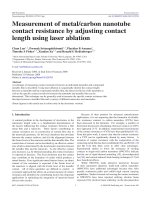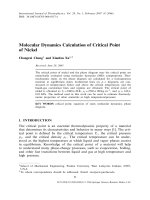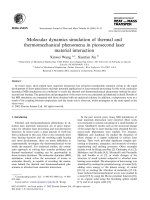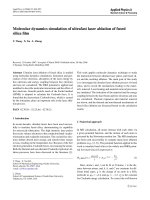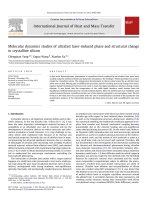molecular dynamics simulation of ultrafast laser ablation of fused silica film
Bạn đang xem bản rút gọn của tài liệu. Xem và tải ngay bản đầy đủ của tài liệu tại đây (370.9 KB, 4 trang )
Appl Phys A (2008) 92: 849–852
DOI 10.1007/s00339-008-4579-y
Molecular dynamics simulation of ultrafast laser ablation of fused
silica film
Y. Wang ·X. Xu ·L. Zheng
Received: 12 October 2007 / Accepted: 4 March 2008 / Published online: 28 May 2008
© Springer-Verlag Berlin Heidelberg 2008
Abstract Ultrafast laser ablation of fused silica is studied
using molecular dynamics simulations. Ionization and gen-
eration of free electrons, absorption of the laser energy by
free electrons and energy coupling between free electrons
and ions are considered. The BKS potential is applied and
modified to describe molecular interactions and the effect of
free electrons. Smooth particle mesh of the Ewald method
(SPME) is adopted to calculate the Coulomb force. It is
found that the electrostatic Coulomb force, which is caused
by the ionization, plays an important role in the laser abla-
tion process.
PACS 02.70.Ns · 52.25.Jm · 42.70.Ce
1 Introduction
In recent decades, ultrafast lasers have been used success-
fully to machine fused silica, demonstrating its capability
for microscale fabrication. The high intensity laser pulses
first excite valence electrons to the conduction band via pho-
toionization and avalanche ionization. The excited free elec-
trons further absorb laser energy, and transfer their energy
to ions, resulting in the temperature rise. Because of the free
electron generation, Coulomb forces exist among the atoms.
Both the thermal and non-thermal (Coulomb explosion) ab-
lation processes have been discussed in the literature [1].
Y. Wa n g · X. Xu (
)
School of Mechanical Engineering, Purdue University,
West Lafayette, IN 47907, USA
e-mail:
L. Zheng
School of Computational Science, Florida State University,
Tallahassee, FL 32306, USA
This work applies molecular dynamics technique to study
the interaction between ultrafast laser pulses and fused sil-
ica and the resulting ablation. The main goal of this study
is to investigate the ultrafast laser ablation process of fused
silica, and to reveal the mechanisms leading to the mater-
ial’s removal. Laser heating and material removal processes
are simulated. The ionization of the material and the energy
coupling between the laser beam and free electrons and ions
are considered. Thermal expansion and material removal
are shown, and the thermal and non-thermal mechanisms of
fused silica ablation are discussed based on the calculation
results.
2 Numerical approach
In MD calculation, all atoms interact with each other via
a given potential function, and the motion of each atom is
governed by the Newtonian motion law. The MD simulation
has been used successfully to compute many laser ablation
problems (e.g., [2, 3]). The potential function applied in this
work to simulate fused silica is the widely-used BKS poten-
tial for fused silica [4] expressed as
Φ
ij,BKS
(r) =
q
i
q
j
ε
∗
0
r
+A
ij
e
−b
ij
r
−
C
ij
r
6
. (1)
Here, atoms i and j can be Si or O atoms, r is the dis-
tance between atoms, and A, b, and C are constants for dif-
ferent bond types, q is the charge of an atom in a SiO
2
molecule as q
Si
=+2.4 and q
O
=−1.2. ε
∗
0
is the constant
for Coulomb energy calculation. To correct the well-known
850 Y. Wang et al.
drawback of BKS potential, the original potential is modi-
fied by a Lennard-Jones 18-6 term [5]
Φ
ij,M
(r) =Φ
ij,BKS
(r) +4ε
ij
σ
ij
r
18
−
σ
ij
r
6
. (2)
Because of the slow convergence of the Coulomb term
(the first term in (1)), Smooth Particle Mesh of the Ewald
method (SPME) [6–8] is applied to compute the Coulomb
term efficiently.
The high intensity of femtosecond laser pulses produces
free electrons from the valence band. These free electrons
have three effects: (1) the thermal effect: free electrons ab-
sorb laser energy and transfer the energy to ions so that
the temperature of the material is increased and the phase
change occurs, (2) the non-thermal effect: due to the genera-
tion of free electrons, the net charge of the Si and O atoms in
aSiO
2
molecule is changed, modifying the Coulomb inter-
action among atoms. Specifically, in our approach, the first
term in the BKS potential (see (1)), the q value is changed
from +2.4to+2.8, and from −1.2to−0.9 for the Si and O
atom, respectively. This is to make sure that the total charge
of the molecule becomes “+1”. There are other ways of
making the total charge “+1”, and this calculation can be
considered as an initial attempt. (3) When the generated free
electrons have an uneven distribution along the direction of
laser propagation, they form an electronic field which exerts
an extra force on ions. This extra force can be estimated by
adding up the electrostatic force vectors from all electrons,
and is calculated as:
Fc =2ε
∗
0
eq
A
k>k
A
n
k
r
k
−
k<k
A
n
k
r
k
, (3)
where ε
∗
0
is defined as in (1), q
A
is the charge of the ion, k is
the index of structure layer, r
k
is the distance between the
ion and the center of layer k, and n
k
is the number density
of free electrons in layer k.
The transient distributions of absorbed laser energy and
free electron density are obtained by solving a wave propa-
gation equation coupled with a rate equation of free electron
generation [9]. The number of free electrons and the num-
ber of SiO
2
molecules whose potentials need to be modified
with respect to depth and time are also obtained from the
wave equation calculation [9] and are randomly distributed
into the y–z plane (the plane perpendicular to the laser prop-
agation direction) of the MD computational domain. Colli-
sions between free electrons and ions result in transfer of
energy from electrons to the ions. In this study, a time con-
stant of 5 ps is used. We also assume the same time constant
of 5 ps for recombination, i.e., for q values changed back to
the values in a neutral molecule.
3 Results and discussions
MD calculations are first performed to obtain the equilib-
rium amorphous structure of fused silica at 300 K through a
so-called “quenching” procedure [10]. The structure of the
Fig. 1 Snapshots of material at
different time steps:
(a) electrons stay in the sample,
(b) electrons go out of sample,
(c) no ionization
Molecular dynamics simulation of ultrafast laser ablation of fused silica film 851
obtained fused silica is analyzed and agrees well with that
reported in the literature [11]. A thin film of fused silica is
considered. The initial thickness of the target is 16.8 nm,
while the lateral dimension is 4.2 nm × 4.2 nm with peri-
odic boundary conditions. The top and bottom surfaces are
subject to free boundary conditions. The laser beam has a
uniform spatial distribution and a temporal Gaussian distrib-
ution of 100 fs FWHM centered at 1.1 ps. The wavelength is
800 nm. Both the pulse width and the wavelength are chosen
to be close to the values of the commonly used Ti:sapphire
femtosecond laser. (Because the film studied here is thin, the
phase change process is entirely volumetric. Therefore, the
term “ablation” used here is different from the traditional
meaning of ablation which is commonly used to describe
material removal from a target surface.)
Figure 1 displays the snapshots of the target at different
time. The incident laser fluence is 4.5 J/cm
2
, and the ab-
sorbed fluence is calculated as 0.055 J/cm
2
(the majority of
laser energy absorption is due to free electrons generated by
multi-photon ionization) [9]. The laser pulse irradiates the
target from the right. Ionization happens just after the peak
of the laser pulse and the Si, O atoms change their charge
values. Once the electrons are generated, free electrons ei-
ther stay inside the target, or leave the target. The percent-
age of electrons leaving the target is unknown. In our cal-
culation, we compute the two extreme cases, i.e., either the
electrons all stay in the target or all leave the target. Also, for
Fig. 2 Temperature distributions in the fused silica film at 40 ps
comparison, we compute the case that no ionization is con-
sidered, in which same amount of energy is deposited into
the system through velocity scaling. This is done artificially
for the purpose of this paper.
In the first case as shown in Fig. 1a, the produced free
electrons stay in the sample, which give an extra Coulomb
force (Fc in (3)) in addition to the static force described
by (2). Strong ablation can be seen at about 5 ps and the ma-
terial continues to expand. For the second case (Fig. 1b), the
free electrons all leave the material after they are generated.
There is no extra Coulomb force (Fc in (3)) in the system. It
is seen that the snap shots of the molecular distribution are
similar to what is shown in the first case. This is because the
electrons are generated quite uniformly inside the thin fused
silica film (a 7% difference of free electron density between
the top and the bottom of the thin film), and perhaps the ab-
lation is influenced more by the changes in the charges in Si
and O. The forces caused by this difference could be small
compared with other Coulomb terms in (2). More analyses
are being performed to clarify this point. Figure 1cshows
the result when no ionization is considered. All atoms do
not change their q values in their potentials. No ablation but
only small thermal expansion is seen.
In Fig. 2, the temperature distributions in the fused sil-
ica film at 40 ps (only for the central parts between gray
lines in Fig. 1a and b) are shown, considering both electrons
staying in and leaving the material. The two cases have sim-
ilar temperature distributions. It is noted that temperatures
of the material can still be defined. This can be seen by
the Maxwellian velocity distribution shown in Fig. 3 (mass
center velocity removed). In fact, the temperatures shown in
Fig. 2 are found by Maxwellian fitting.
The most significant result from the calculations is that
there is no strong ablation without the free electrons effect.
Therefore, it can be concluded that the free electron effects
play a significant role in material’s removal. The threshold
laser fluencies for ablation is 4.14 J/cm
2
(absorbed fluence
0.03 J/cm
2
) when the free electron effect is considered. If
the electron effect is not considered, strong ablation is only
observed when the laser influence is higher than 5.4 J/cm
2
.
Figure 4 shows the snapshots of the molecular distributions
Fig. 3 Velocity distribution and
Maxwellian fitting for
(a) electrons staying in the
sample, (b) electrons going out
of the sample (only for the
central parts between gray lines
in Fig. 1a and b)
852 Y. Wang et al.
Fig. 4 (a) Snapshots and
(b) velocity distribution at a
laser fluence 5.4 J/cm
2
when no
ionization is considered (only
for the region between gray
lines)
at a laser fluence of 5.4 J/cm
2
(absorbed fluence 0.1 J/cm
2
).
The temperature at 40 ps is about 16,000 K, as shown in
Fig. 4b (mass center velocity removed).
4 Conclusion
In conclusion, ultrafast laser ablation of fused silica is sim-
ulated using the molecular dynamics technique. Ionization
and generation of free electrons, absorption of the laser en-
ergy by free electrons, and energy coupling between free
electrons and ions are considered. The smooth particle mesh
of the Ewald method (SPME) is adopted to calculate the
electrostatic Coulomb force, which is found to play an im-
portant role in material’s ablation.
Acknowledgement Support to this work by the Sandia National
Laboratory and the National Science Foundation is acknowledged.
References
1.R.Stoian,A.Rosenfeld,D.Ashkenasi,I.V.Hertel,N.M.Bul-
gakova, E.E.B. Campbell, Phys. Rev. Lett. 88, 0976031 (2002)
2. L.V. Zhigilei, Appl. Phys. A 76, 339 (2003)
3. C. Cheng, X. Xu, Phys. Rev. B 72, 1654151 (2005)
4. B.W.H. Van Beest, G.J. Kramer, R.A. van Santen, Phys. Rev. Lett.
64, 1955 (1990)
5. Y. Guissani, B. Guillot, J. Chem. Phys. 104, 7633 (1996)
6. P. Ewald, Ann. Phys. 64, 253 (1921)
7. L. Zheng, PhD thesis, University of Rochester, 2004
8. U. Essmann, L. Perera, M.L. Berkowitz, T. Darden, H. Lee,
L.G. Pedersen, J. Chem. Phys. 103(19), 8577 (1995)
9. A.Q. Wu, I.H. Chowdhury, X. Xu, Phys. Rev. B 72, 0851281
(2005)
10. C. Cheng, A.Q. Wu, X. Xu, J. Phys. 59, 100 (2007)
11. K. Vollmayr, W. Kob, K. Binder, Phys. Rev. B 54, 15808 (1996)
